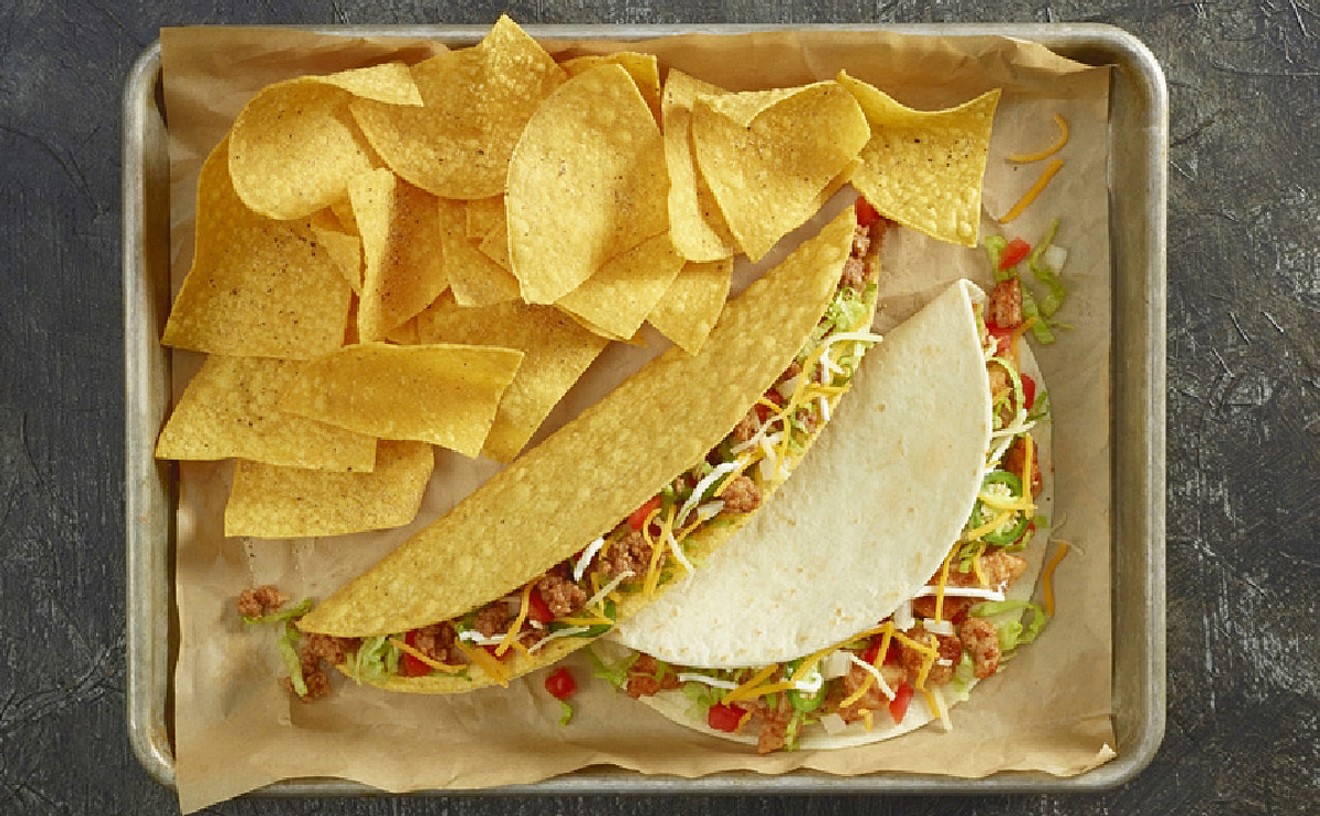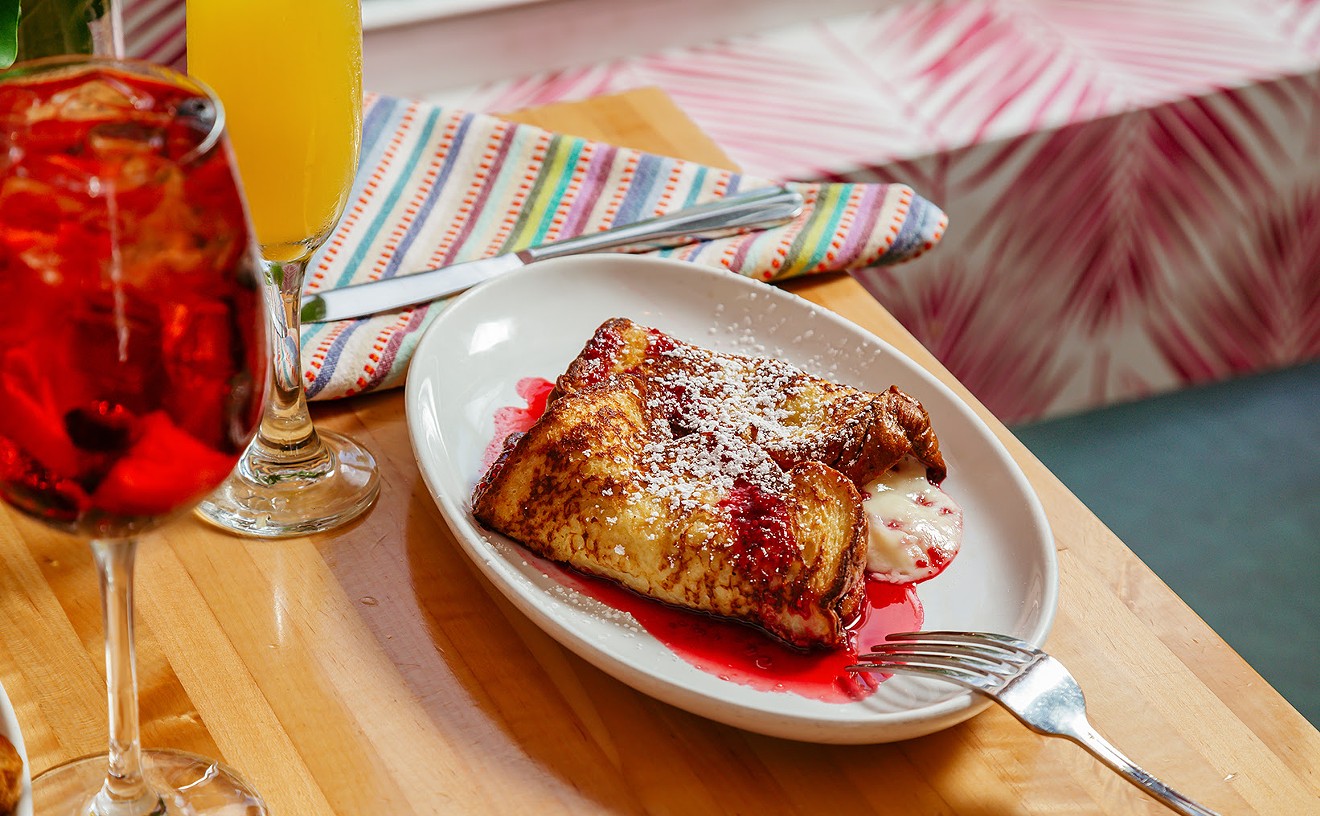It used to be easy to differentiate between a fine-dining establishment and a neighborhood restaurant. The former's tables would be draped in white linen, the patrons in elegant attire, and the host — referred to as "maitre d'" — would likely be wearing a tuxedo. Further clues might be ascertained via soft strains of classical music in the background, a trolley cart of cheeses rolling through the dining room, formal service executed by waiters with the bearing of proud professionals, and diners in full possession of their meals, not passing them around to share as in some family-style trattoria. The presence of duck al'orange on the menu was always an easy giveaway, and of course a perusal of prices would settle any doubts.
This all changed in the Nineties, when a young generation of chefs reconfigured the parameters of upscale dining. Chic cuisine was placed upon bare tables (an economic boon, because linen service at a busy eatery can run upward of $100,000 per year). Waiters were more personable — chatty, even. Trolley carts went the way of trolley cars. Dress codes got shelved. Beethoven became Buddha Bar. The "fine" line is now more difficult to divine.
Consider Talula, the heralded South Beach restaurant: Is this an upscale establishment dressed down, or a neighborhood haunt posing as haute? At first glance, it seems as if a case could be made either way, for Talula purposefully plays the middle ground — all the better for attracting locals and tourists alike. The cozy décor suggests haunt, a handsome hangout warmed with brick, wood, and a rustic mustard/cinnabar/copper color scheme. Linen napkins are the only cloths to grace the black-topped tables. A full bar occupies the left side of the space, and an open kitchen in back features five ringside seats for looking in on the action. A well-foliated outdoor patio is equipped with an abundance of fans blowing down from a cloth-draped canopy.
When Talula first opened in June 2003, its culinary style could have been labeled "cutting-edge comfort food" (the owners call it "creative American cuisine"). Influences remain the same — some dishes based on Asian ingredients, others invoking the Mediterranean or American Southwest. Presentations are contemporary in design — neat, clean, and vertical, often with a protein sandwiched between starch base and herb/garnish top, pooled in a translucently light sauce. It doesn't seem very cutting-edge anymore, but that's all right.
Talula's room snaps to on weekends, but on other evenings the energy level is down, the staff operating on remote: Patrons receive a perfunctory greeting on their way in, and no goodbyes on the way out. Managers possess a professional polish, as do some servers, and the sommelier makes suggestions in appropriately reverent tones (the wine list, with more than 180 global selections, likewise bespeaks sophisticated dining — especially the markup, in many cases four times retail). Other workers affect more of a cheery coffee shop demeanor.
On one visit, about 20 seconds after receiving appetizers, our waiter came over to ask "Is everything delicious?" and repeated the question after each course. Not only did the reiteration make the server's sincerity seem rote, but also the phrasing didn't leave much wiggle room. What if a pair of succulently seared diver scallops was delicious, as was a crown of creamy sherry-spiked foam, but an accompanying butternut squash griddle cake was too mushy to provide textural contrast — and the green lentil-cashew-ham "cassoulet" beneath the bivalves cried out for a more potent poke of smoky pork to balance briny and sweet? It was a gratifying starter, but not everything was delicious. Plus watercress sprigs on top were wilted and practically leafless; I remember when Talula used to embellish its dishes with fresh, frisky sprouts.
The resumés and reputations of Talula's husband-wife proprietors, Frank Randazzo and Andrea Curto-Randazzo, are up-market all the way. He is the former James Beard-nominated chef of Pacific Heights and the Gaucho Room; she was recognized as one of Food & Wine magazine's "Ten Best New Chefs" while helming Wish. Andrea is the head culinarian these days; Frank takes care of business up front. The two are raising a family but remain involved in running the operation. Between changing diapers, they have also altered the menu a number of times.
Heated slices of prosaic baguette with garlicky white bean spread can certainly use updating, the latter having become so ubiquitous it will probably start showing up at Denny's one of these days. Interestingly no amuse-bouchée is served (unusual for upscale dining; not at all for a local joint).
Talula's offerings are diverse enough to satisfy diners of different stripes. Modern-minded masticators might opt for the signature starter of grilled Canadian foie gras with blue corn cakes, caramelized figs, and spicy red chili syrup, while meat-and-spud types can sink their fangs into one of "Frank's char-grilled steaks" with a side of roast garlic mashed potatoes. If you were to order both and call it a dinner, the price, sans anything else, would be $60 or more (depending upon the cut of meat). That's not so neighborly.
Nor are appetizer prices, which begin at a lofty $14 and climb to $19. They are good, though, from those sumptuous scallops to "cork-braised" octopus (cork placed in the liquid for tenderizing), tastefully charred if slightly tough tentacles combined with fresh artichoke bottoms and Costa Rican hearts of palm. Not much high-low in terms of contrasts, because the trio of ingredients is inherently neutral in flavor, but olive oil, lemon juice, and piquant cracklings of black peppercorn ably accented those natural tastes, as did tartly dressed arugula leaves on the side.
Twisted twirls of trofi pasta were to come embellished with shrimp, scallops, clams, summer squash, and lemon "pistou" (a paste of basil, garlic, and olive oil). The waiter informed us of there being no clams in the house, but I ordered it anyway. The two shellfish and trofi arrived toothsomely tossed with tomato, lemon, parsley, olive oil, and garlic. I anticipated the lack of clams, but not the missing basil and squash. Appetizer portions of pasta are $13 to $15; regular orders run $24 to $27.
Most entrées cost $25 to $29, or about $10 less than at other elite eateries around town. This slightly offsets the costly starters, but the final bill here is indisputably high-end. So are the steaks, which go for $36 to $48 — excepting a $24 Black Angus hanger and $84 prime-aged tomahawk chop. Upon being asked for a description of the latter, our waiter waxed ecstatic on the 32-ounce chop and opined that I would enjoy it far more than the hanger I had ordered. If one calculates a 20 percent gratuity, the difference between a $24 and $84 steak amounts to a $12 tip differential. The waiter's exuberance in pushing the tomahawk made it too apparent she had likewise done the math. Instead of adding numbers, she should have noted that my pasta appetizer would have made two pounds of meat too much to handle, especially with a pair of giant, crisply crusted beer-battered onion rings that come alongside. There was no disappointment with the hanger steak — tender and sweet from Asian-style marinade, grilled to a perfect medium-rare, and boosted by a buoyantly beefy Cabernet demi-glace.
Although Talula is not at the forefront of culinary trends, the cuisine is ambitiously innovative. What else can one say about spiced duck breast with peanut butter mashed potatoes and sherry-curry gastrique? Or two seared spears of snapper with pignoli risotto, Key West shrimp, and anisette-kumquat butter sauce dotted with chocolate-chili caramel? In some hands this would be overkill, but the subtly applied flavors were spot on. The only downside was the mushily overcooked risotto — plus Key West crustaceans always taste to me like larger versions of those insipid, baitlike minishrimp.
A hefty hunk of bone-in pork chop came smoky from the grill and fluffed in the center with sausage stuffing. The plate was stuffed, too, with caramelized apples, runner bean ragout, garlic-sautéed broccoli rabe, and a potent grainy mustard sauce. That's a lot of diverse flavors, and plenty to eat, but just the same, you won't want to miss the à la carte accompaniment of Roth Käse Wisconsin GranQueso and Vidalia onion tart: a square of flaky, buttery crust topped by a lusty custard with the sweet, sharp, Manchego-like notes of GranQueso. It's a bit rich as a side, but with salad, bread, and a glass of Rioja wine, it would make a perfect bistro meal. And a moderately priced one at that.
Talula dresses classic desserts with dashing accouterments such as Thai basil syrup on key lime pie, and heavenly lavender ice cream atop peach-blackberry cobbler. The latter didn't possess enough crust and hardly, if any, peaches. It was oversweetened, too, and a protruding pink peppercorn tuile tasted old. That said, fresh warm berries and ice cream simply can't be bad. Banana-chocolate bread pudding was uncommonly light, skillfully balanced, and fetchingly partnered with vanilla malted milk sauce.
In the end, Talula can be what you want it to be — a neighborhood restaurant with uncharacteristically good food and inordinately high prices, or a reliable and relatively affordable fine-dining destination.










